By Todd Burgreen
Why did Kel-Tec introduce a 30-round capacity .22Magnum (.22WMR), 4.3-inch barreled, polymer semi-automatic handgun into the market? Is it for personal defense, a trail/kit gun, target shooting, or dare we say just for fun? The PMR-30 seems counter-intuitive, especially when compared against other semi-automatic pistol “understudy” types most often chambered in 22LR that are modeled after a centerfire “big brother.” The “understudy” 22LR handguns offer similar feel and balance while being chambered in 22LR versus 9mm, 40 S&W, 45ACP, etc. These types of 22LR handguns are ever increasing in popularity. This is based on facilitating more economical practice/training and making sure the fundamentals of trigger control, sight alignment, grip and all the other marksmanship tenants are followed without the interference of muzzle blast and recoil; all the while maintaining similar feel and operating controls of their full-power “big brothers.”
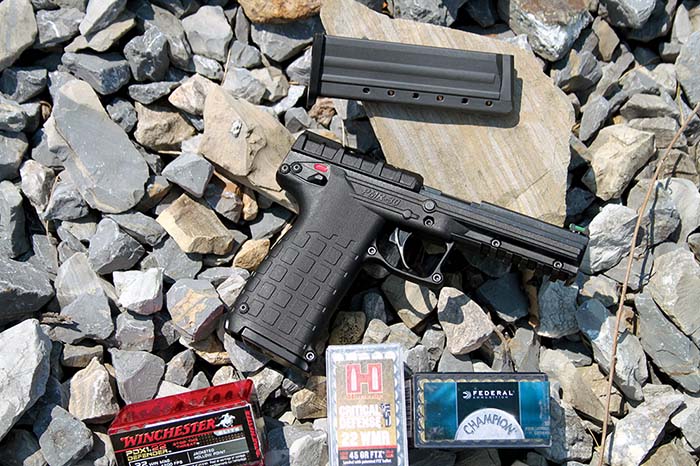
The Kel-Tec PMR-30 stands alone and defies easy categorization. It rejects being labeled as only an “understudy.” It is easy for the Kel-Tec PMR-30 to separate itself from the competition with its .22WMR chambering and ultra-high capacity alone. However, additional PMR-30 features further add credence to its uniqueness in terms of design and construction. The PMR-30 does not pose as an understudy since controls, grip angle and other intangibles of feel do not mimic any other handgun out there. Do not take this to mean it has no value as an introductory handgun. While the PMR-30’s muzzle blast will surprise with a signature more typical of a centerfire cartridge, recoil is minimal and thus manageable by all shooters. Though popular as a manually operated rifle and revolver round, few manufacturers have attempted to build a semi-auto rifle or handgun in .22WMR. This stems from various reasons such as .22WMR cartridge length standards, the case rim specifications and variations in pressure levels of different brands of .22WMR ammunition. However, Kel-Tec decided to tackle these issues in creating the PMR-30.
Some History
Initially founded in 1991 as a machine shop, Kel-Tec CNC Industries, Inc. started manufacturing firearms in 1995. Kel-Tec prides itself on specializing in innovative rifle and handgun designs for law enforcement personnel and security-conscience citizens. Along these same lines Kel-Tec has succeeded in creating an interesting twist with many firearm designs with its out-of-the-box thinking. A brief look at their website will show the bullpup KSG 12-gauge shotgun and RFB semi-auto 7.62x51mm NATO rifle, the compact foldable Sub-2000 pistol caliber carbine and SU-16 5.56 rifle. Kel-Tec’s fresh approach to firearm design always generates interest. The PMR-30 .22WMR handgun falls squarely into this mold.
Design
Kel-Tec engineers turned to magazine design and a hybrid action combining blowback and locked breech features in an effort to tame the .22WMR chambering. The magazine is oft described as pie-shaped with the tapered end toward the bullet end of the cartridge and rim toward the wider area. Kel-Tec describes proper procedures for loading the PMR-30 magazine to help in reliable operation of the PMR-30. The requirements are not onerous with the case inserted into a segment of the magazine lips before being pushed to the rear of the magazine. After every five or so rounds are loaded the magazine is to be tapped on something solid such as a palm, leg, table, etc., to help seat the rims into the magazine without getting out of orientation sequence. The magazine loading method is straightforward and does not take any more time to complete than random jamming of rounds into a magazine. Indeed, it makes one wonder how people load magazines in any different fashion. Loading directions were purposely ignored to test the effect on the PMR-30’s reliability. It was determined that a malfunction was likely if the simple magazine loading directions were not followed—thus, best to adhere to the Kel-Tec directions.

Kel-Tec engineers continued adapting the PMR-30 to the .22WMR past the magazine design. The PMR-30 operates via a hybrid blowback/locked-breech system. One of the potential issues with .22WMR semi-automatic pistols is the wide range of pressures generated by factory ammunition. Kel-Tec designed a new action that automatically and seamlessly adjusts between locked-breech and blowback operation, depending upon the pressure generated by the particular cartridge that is being fired. In simple terms, the barrel is allowed to float forward and backward a small amount in the frame. This is very similar to any design using a variation of Browning’s tilting barrel, short recoil design; however, the Kel-Tec PMR-30 has no mechanical locking system. The method of operation is determined when the cartridge case forms to the chamber during firing. If the pressure generated in the cartridge is high enough, friction will cause the case to “stick” to the chamber walls, and the barrel will recoil with the slide until pressure drops—just like a typical locked-breech firearm. If the pressure is lower, the barrel stays virtually still, and the slide recoils like a blowback firearm. This innovative system does not require chamber-friction reducing methods like fluting or porting as seen in other .22WMR autoloaders. It allows the PMR-30 to fire a wide variety of ammunition without sacrificing reliability.
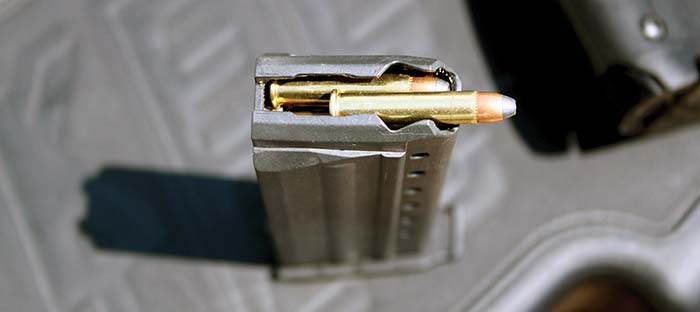
The PMR-30 follows a similar pattern to other Kel-Tec designs using glass-reinforced nylon (Zytel) and an aluminum frame in its construction with only the barrel and portion of the slide being steel. The PMR-30’s action incorporates a recoil buffer and dual opposing extractors for reliability when combined with the hybrid operating action described above. The Zytel material facilitates lower manufacturing costs as well lighter weight for the full-size frame found on the PMR-30. As for specifics, the PMR-30 is a semi-automatic, single-action pistol with an internal hammer/striker. A 4.3-inch barrel is used. Overall length is 7.9 inches, and the height is 5.8 inches. The empty weight is only 13.6 ounces. A loaded magazine weighs a mere six ounces. This means that a fully loaded PMR-30 weighs less than 1.5 pounds. Kel-Tec has installed fixed fiber optic front and rear sights onto the pistol. The front sight is adjustable for windage only. The front color is yellow/green, and the rear is orange/red. PMR-30 controls are minimal—trigger, ambidextrous safety and slide lock lever. The dust cover features an integrated Picatinny style rail for attaching lights or other accessories an end user may desire. In front of the rear sight one will find four screws indicating that Kel-Tec has tapped and threaded the slide to accommodate one of the many miniature red dot sights hitting the market. Bases are available from Kel-Tec depending on what type of red dot a user may choose. The magazine release is a European-style heel release at the base of the grip. Each pistol ships with two magazines and padded plastic case. As expected the magazines, considering the use of Zytel in the handgun frame, are constructed of high-strength polymer.
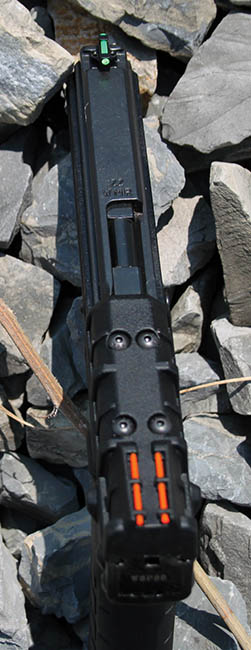
Testing at the Range
The PMR-30 was tested with a myriad of ammunition from Hornady, Winchester and Federal such as Hornady 22WMR 30gr. V-MAX and 45gr. FTX Critical Defense; Federal JHP and FMJ; and Winchester FMJ and 45gr. PDX1 Defender JHP. Kel-Tec ships the PMR-30 with recommendations and more importantly a list of ammunition that they council against—mostly non-U.S.-made .22WMR. Range time exhibited all positives in terms of performance and reliability. The trigger pull was a pleasant surprise in terms of minimal creep and weight required to initiate cartridge ignition. RCBS gauge averaged just under 4 pounds after averaging 10 pull tests.
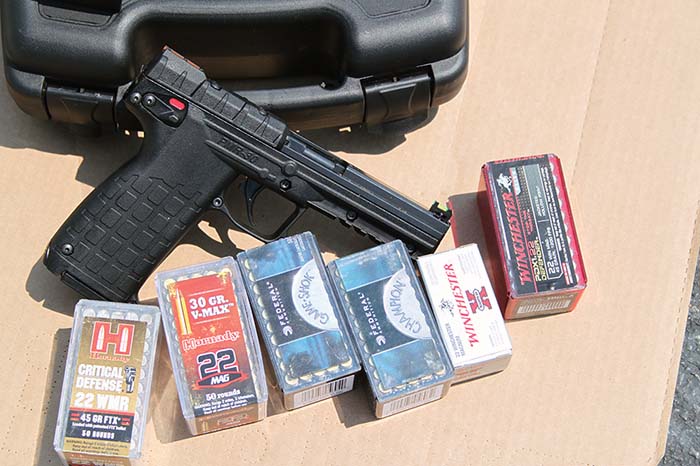
Unequivocally, it can be reported that no issues were encountered during evaluation of the Kel-Tec PMR-30. Why such a strong statement? This is based on various reports of problems encountered in the PMR-30 that were uncovered during research of this article. This is not meant as refutation of these reports only that this PMR-30 performed without issue. In all fairness, Kel-Tec themselves admit to product evolution in the PMR-30. For example, the barrel’s twist rate was altered from 1:16 to 1:11 based on feedback from customers related to key holing issues. Another complaint often heard is that the PMR-30 is not being produced and sent to retail shelves fast enough since its 2010 SHOT Show introduction. Frankly, this is outside the preview of this article.
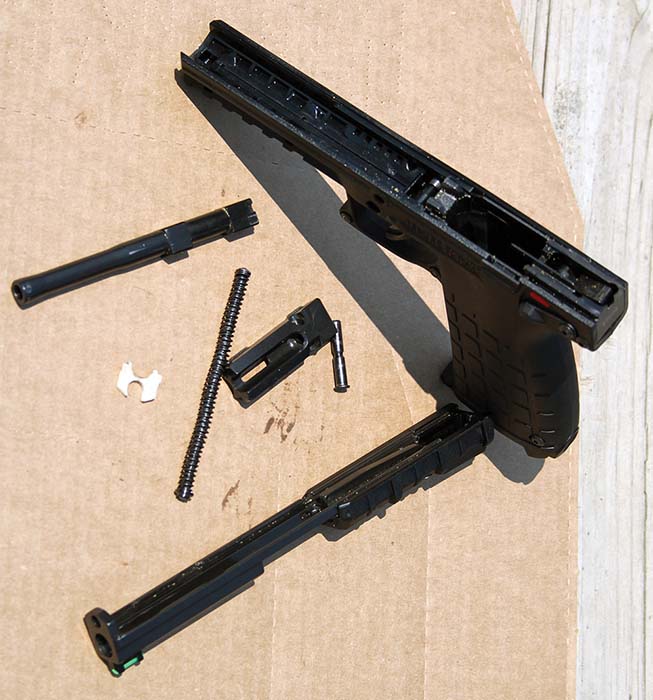
With a 30-round magazine it did not take long to send large quantities of rounds downrange during this evaluation, with many willing volunteers stuffing magazines and running the PMR-30’s trigger. One interesting nuance discovered with the PMR-30 was that the slide could not be “sling-shot” forward during reloads once the slide locked rearward after the last round was fired. The slide release lever had to be used. This is not a big deal, just worth noting. Another anecdote is the surprisingly loud blast and muzzle flash that the PMR-30 emits. This is based on the .22WMR being primarily chambered in rifle-length barrels and thus the use of slower burning powders that do not get consumed in the PMR-30’s 4.3-inch barrel. Quite truthfully, this made firing the PMR-30 more like the experience of firing a centerfire defensive handgun without the associated recoil. Plate racks and other targets strewn around Echo Valley Training Center (EVTC) were engaged repeatedly as were more traditional paper targets in an effort to get the full sense of the PMR-30’s capabilities.
PMR-30’s Role
As with many new products the PMR-30 was initially touted as filling a role it was never intended to do. The PMR-30 was labeled as the “poor man’s” 5.7x28mm handgun in reference to the FN FNH introduction of its Five-seveN handgun. The PMR-30’s high capacity and chambering in the .22WMR versus 22LR was behind this misleading statement. The two weapons share similar aesthetic lines, dimensions and are light weight. This is where any similarity ends as the .22WMR does not compete with the 5.7×28 in terms of velocity achieved in either a handgun or rifle and was never intended to when it was designed. The PMR-30 chronoed loads across an RCBS Chronograph in the 1200-1400fps range depending on bullet weights being fired.
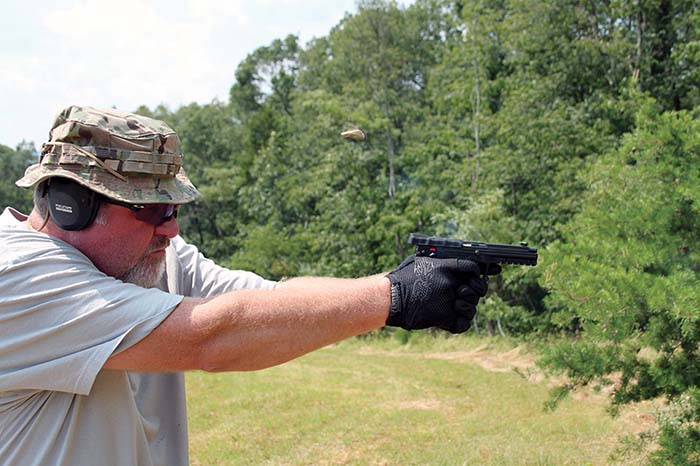
Accuracy with the rimfire PMR-30 was more than acceptable and probably superior to what most users are capable of when being fired from any non-bench position which is the reasond’etre of the PMR-30 to begin with. It is no problem keeping rounds in the “A” zone of the IPSC targets back to 25 yards and very possible further out as long as users pay heed to sight alignment and trigger control resisting the temptation to blast rounds downrange knowing 30 .22WMR rounds were sitting in the magazine awaiting release.
Ammunition
In terms of ammunition, it was a surprise to find a number of .22WMR loads directed towards the personal defense realm. Both Hornady and Winchester offer prime examples of this in the form of Hornady’s 45gr FTX Critical Defense and Winchester’s 45gr PDX1 loads.
Conclusion
As questioned at the beginning of the article: is the PMR-30 a candidate for personal defense, a trail/kit gun, target shooting or dare we say just for fun? Users will have to decide what roles the PMR-30 will fill in their collection. It can be stated that the evaluated PMR-30 performed without issue, and its high capacity in a surprisingly light-weight package is extremely attractive in whatever role it is destined for.
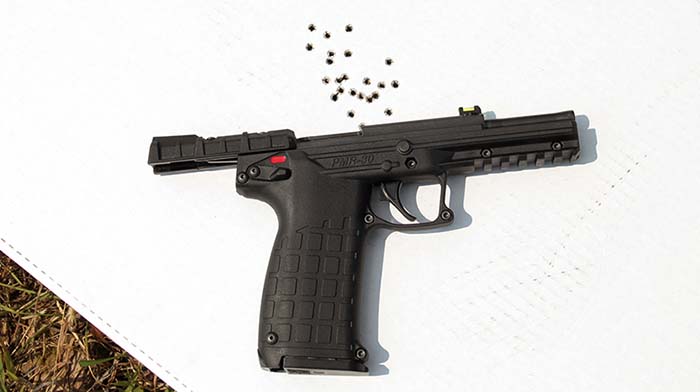
| This article first appeared in Small Arms Review V23N2 (February 2019) |










